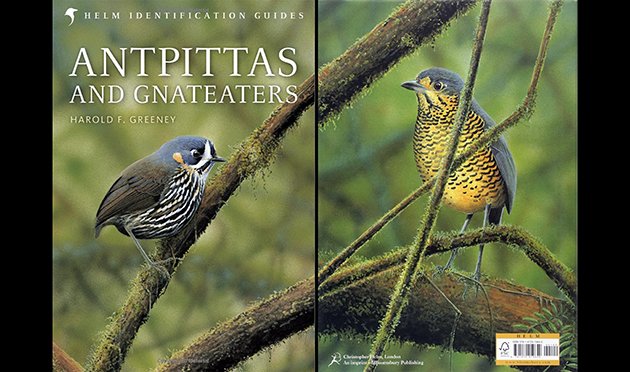
Antpittas and Gnateaters by Harold F. Greeney was recommended to me as a book I HAD to review by no less than three birding friends. I hesitated because a 496-page book about two skulky neotropical bird groups is a little intimidating. It’s a fairly large book considering the limited subject matter. I also wondered if a book like this would be of interest to 10,000 Birds readers. Then, I remembered how often 10,000 Birds writers have written about Antpittas. Who can forget Mike and Corey’s stories about Maria, the Giant Antpitta at Refugio Paz de Las Aves, Ecuador, or James Currie‘s quest to see the Scaled Antpitta at Tandayapa Lodge? Patrick has had his share of sightings in Costa Rica as well. And, I looked at my eBird list and realized I’ve seen nine species of Antpitta and one of Gnateater.
Antpittas and Gnateaters covers 64 species in six genera and two families. (I had no idea there were so many Antpittas, though at least one species, Alta Floresta Antpitta, is not considered a separate species by BirdLife International.) There are two major sections: (1) Plates and (2) Species Accounts, plus an introduction on “Layout of the Book,” and an extensive Bibliography and Index.
Plates
The plates feature the artwork of David Beadle, with beautifully painted images carefully laid out opposite brief text. The Species Accounts feature highly detailed text by Harold Greeley, distribution maps, and over 250 photographs by a number of photographers. It’s a book that wants to have it all–artwork and photos; brief identification text and page-long, in-depth plumage descriptions; personal observational notes next to lengthy paragraphs listing measurements of wing, bill, and tarsus.
Here’s Plate 3, the third plate for Conopophaga, one of the two genera of the Gnateater family. Three species are illustrated: male and female images for Hooded and Ceara Gnatcatchers, and 2 adults (differing subspecies) and a juvenile and a fledgling for Rufous Gnateater. This range of illustration continues throughout the 24 plates, reflecting, I assume, what has been documented and not documented for each species and the degree of difference between sexes and amongst subspecies. (Although the introduction thoroughly describes the Species Accounts, there is little on the Plates, leading me to wonder if Greeney or Beadle wrote the left-hand page text.) The artwork is beautiful. It’s amazing how Beadle was able to draw so many birds of similar shape and pose and make each one an individual. But, then again, this is an artist and photographer who has illustrated and co-written books on sparrows and moths!
The text opposite the plates lists common and scientific names; length of bird; brief notes on how the sexes do or don’t differ; comparisons to similar looking Antpittas and Gnateaters; brief description of distribution; whether or not we know about the bird’s nesting biology; and if it is classified on the critical end of the Red List of Threatened Species. Notes are also given on the distribution of subspecies. Most conveniently, we are given the page number of the species account for more–much more–information.
Species Accounts
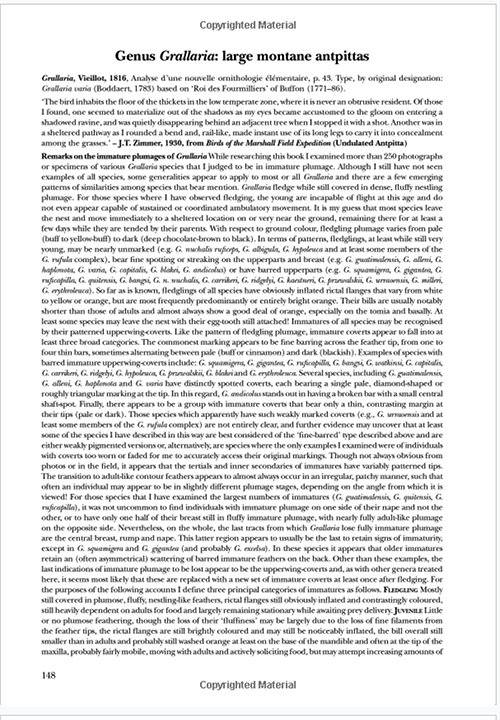 Species Accounts vary greatly in length, from nine pages for Undulated Antpitta to two pages for Alta Floresta Antpitta, length depending not only on how much we know about the bird but also Greeney’s tendency to thoroughly discuss, even argue, any kind of confusion in documentation, taxonomy, or research results. This is particularly true when it comes to sorting out subspecies.
Species Accounts vary greatly in length, from nine pages for Undulated Antpitta to two pages for Alta Floresta Antpitta, length depending not only on how much we know about the bird but also Greeney’s tendency to thoroughly discuss, even argue, any kind of confusion in documentation, taxonomy, or research results. This is particularly true when it comes to sorting out subspecies.
The length and dense text of these accounts is intimidating. The print is small, many pages are all text (photographs are organized together rather than spread out), and although bold print is used to set off discrete chunks of information and sections, much of the book looks like nonstop citations, numbers, and Latin to the browsing eye. I highly recommend reading the introductory “Layout of the Book,” where Greeney explains his reasoning behind each section of the account (and where you will also get a sense of how much work and thought he put into this project).
Each Species Accounts begins with the basics according to Greeney: Common and scientific names, Plate number, full citation of the article that first described the species, often followed by information about the name origin, type specimens. A “broad brush summary” follows (p.11). I thought this was the most engaging and readable part of each Species Account, though in most cases the broad brush is more of a deep preliminary stroke. Greeney lets go of his rigorous research style and has fun, offering quirky details (Scaled Antpitta “holds the somewhat dubious honour of being the antpitta most frequently recording dying in collisions with windows!”); quotes from early ornithological literature (most describing haunting encounters with antpittas in isolated places); accounts of the feeding methods pioneered by Angel Paz; and, of course, brief descriptions of habitat, distribution, appearance and vocalizations, feeding and breeding behavior, taxonomic status, state of research, and, in some cases, contributions to the literature being made by the book itself (unpublished research and data).
Identification is summarized in the next section, including size, appearance, sexual plumage differences, geographic plumage variations, and comparison to similar species. The latter is particularly important, considering the structural similarities amongst all antpittas (aren’t they all long-legged, round-headed, patterned ovals that stand almost erect and look almost humanly inquisitive?). I do think that if you are considering using this book chiefly for field identification, you are better off using a field guide, a book that emphasizes major field marks in a format made for quick reading.
A distribution map shows areas in South America where the species has been found, with letters and dotted lines indicating subspecies areas, red dots showing where the type specimen was found, and X’s denoting questionable sightings. More detailed geographic information is found in the text Distribution section, which actually includes longitude and latitude for some species! Migratory and altitudinal movements are not common with these species; when they are present, they are described in a Movements section.
The next few sections–Habitat, Voice, Natural History–go into more detail. Greeney refuses to be boxed in by any kind of habitat scheme, so rather than simply saying ‘rainforest,’ or ‘forest edge,’ he offers more detailed descriptions, like “relatively undisturbed forest” (Giant Antpitta), and “humid forest with a high canopy and a relatively dense understorey” (Variegated Antpitta). Voice compiles information from field articles, which ranges from simple transliterations to acoustic notations and measurements. Natural History is another favorite section, descriptions of behavior–how it forages for food, whether it tends to be solitary or part of a group, if the species can be trained to receive food from humans, method of movement (hopping or running), what time of day the male bird tends to sing, and more.
At this point we’re getting into the more detailed sections. Most of what follows Natural History is material rarely found in your average field or identification guide. There are sections on Diet, Reproduction, Technical Description (details on plumage), Morphometric Data (measurements), Distribution Data, Taxonomy and Variation (including subspecies), Status (vulnerability), Other Names (historic, geographic variations, different languages). The Reproduction section is particularly notable. This is Greeley’s passion, and if he didn’t state this himself in the Preface, I’d know it from Rudy, my guide in Mindo who worked with Greeley on various nesting research projects. The length of the Reproduction section varies according to the research, and a well-research species like Chestnut-crowned Antpitta will have almost three full pages of material on where nests have been located; what they look like; composition and size, number of eggs in each nest; description, weight, and size of the eggs; incubation behavior; description of hatchlings; child rearing practices, and ages at which babies fledge; and seasons of nest making and breeding. Many of these accounts include unpublished information from Greeney’s own research. To get an idea of how much research he’s one, his articles on reproduction take up over two columns in the bibliography.
The photographs accompanying the Species Accounts show Antpittas and Gnateaters as hatchlings, fledglings, and adults, on the floor of the forest and perched on low branches. There are photos of parent birds on the nest, baby birds in the nest, and the nest without parent, holding a clutch of blue eggs. In the few cases where Greeney was unable to procure a photo, like Gray-naped Antpitta, he uses a photo of a museum specimen. The photographers are acknowledged in the introduction, and each photo includes photographer’s name and date. In addition to the photographs and Beadle’s artwork, Greeney himself has four exquisite drawings in the introduction. They are, of course, of antpittas building or incubating eggs on a nest.
Organization
A brief word about the organization of the book, which utilizes classic finding aids and does them well. The Contents page gives plate number and book page number for each major section and for each species in the Species Accounts (something many guides surprisingly do not do). The Index lists species by common and scientific name and subspecies by scientific name, giving plate numbers in bold and text pagination. So, you should be able to find the gnateater or antpitta you’re looking for fairly quickly, assuming you know the name. For browsers (me!), the Species Accounts print the genus name in the upper left-hand corner and the species name in the upper right-hand corner. The incredibly long bibliography (50 double-columned paged) of journal articles, web articles, and books is very impressive. It would be shorter if Greeney had used the usual abbreviations for articles with many authors. He doesn’t say so, but I like to think that Greeney wants to give credit to every single person who contributed to the body of research on his beloved antpittas and gnateaters.
Conclusion
Many birders (including me) have visited Refugio Paz de las Aves, where Angel Paz discovered that Antpittas and other shy birds could be coaxed out into the open with regular, gentle feedings. His methods have been adopted by other reserve operators, resulting in thousands of birders seeing, photographing, and adoring Antpitta species that birders could only dream of in earlier years. Greeney has been captivated by Antpittas and Gnateaters since 2000, particularly by their nests and reproductive biology. Antpittas and Gnateaters is his passion project, a compendium and analysis of arguably every single research article, note, working paper, piece of unpublished research that ever existed. There is possibly more information in The Handbook of the Birds of the World, but I doubt it. For one thing, HBW doesn’t have a 50-page bibliography. Nor does it have Greeney’s obsession with citing every single observation, be it the weight of an egg or the audiological level of a high-altitude song, from these articles
Books that focus on a bird family tend to be mostly about identification and plumage. One of the reasons I wanted to review Antpittas and Gnateaters was that I was curious about whether it could stand as a model for future bird family books. The book certainly goes beyond identification, with much valuable information on behavior, diet, and nesting. But, I doubt if one person is capable of putting in the years of work in the field, the obsessive attention to minute detail on the page, and the absolute love of subject to accomplish what Greeney has achieved here. This is one impressive book, and I understand why Carlos, Jacob, and a friend who wants to remain anonymous recommended it. It’s not a book for everyone, but Neotropical bird enthusiasts who intensely bird South America will want to read it before and after every trip.
Antpittas and Gnateaters
by Harold F. Greeney, illustrated by David Beadle
Helm Identification Guides series
Helm, Bloomsbury Publishing, Sept. 2018
496 pages, 7.1 x 1.5 x 9.6 in.
ISBN-10: 1472919645; ISBN-13: 978-1472919649

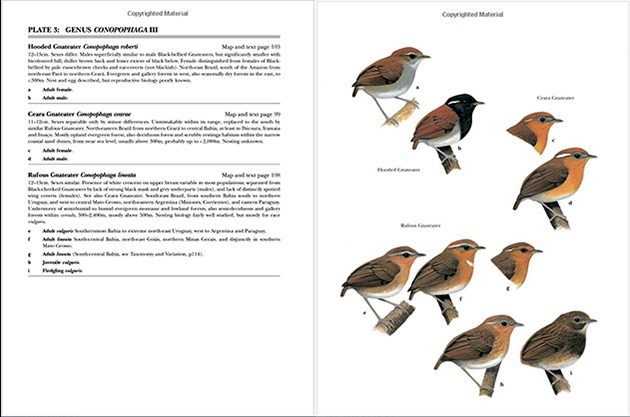
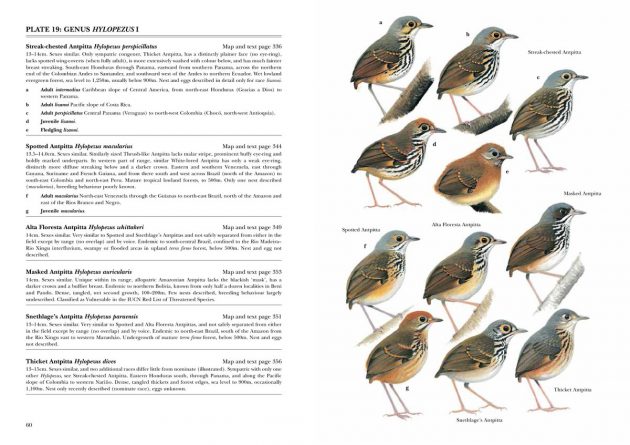
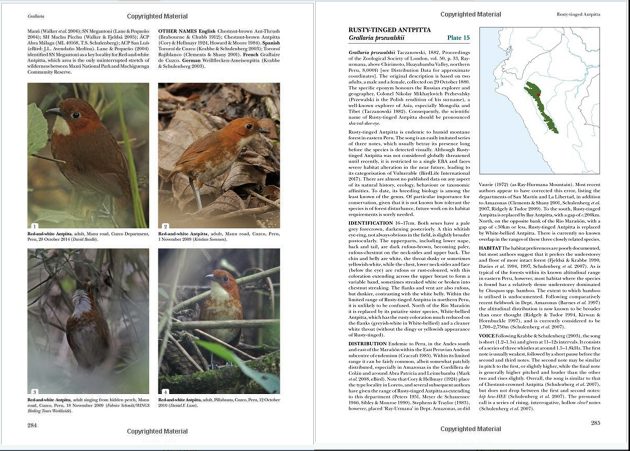
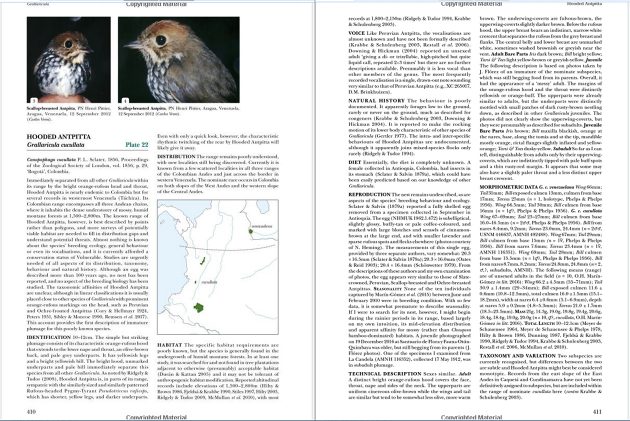
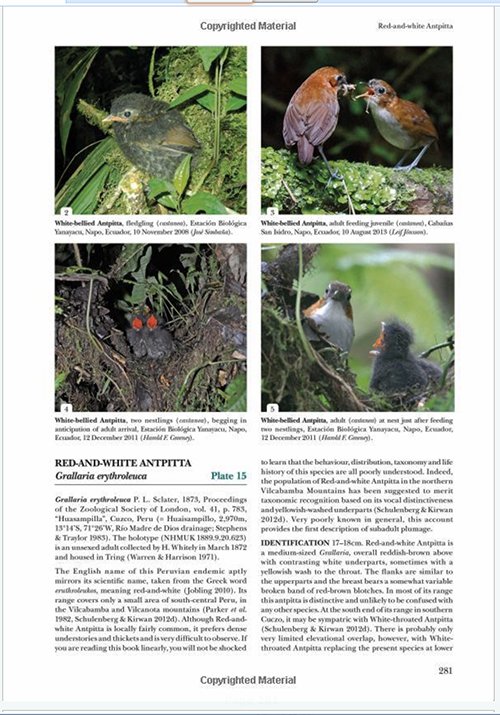
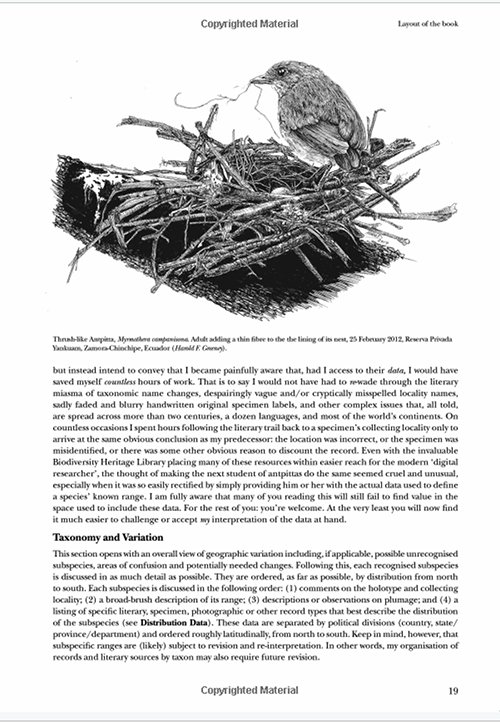
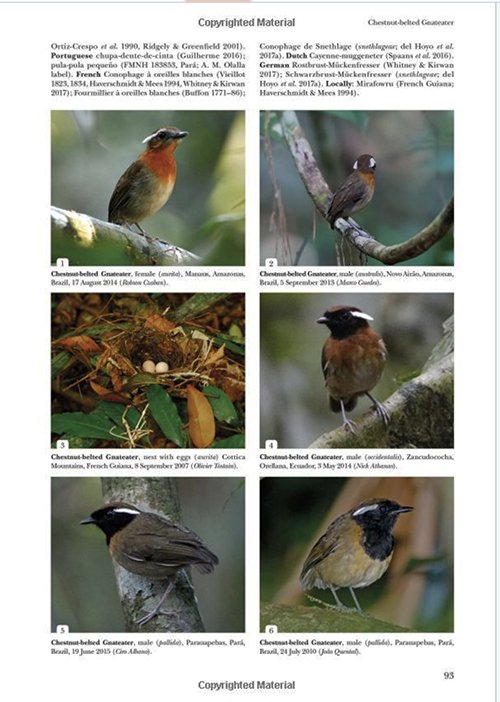










Leave a Comment